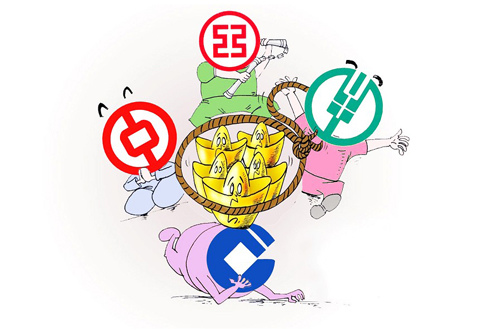
(Ecns.cn) – Twelve of China's listed banks reported record net profits for 2011, of which the top four state-owned banks reported 623.61 billion yuan (US$98.97 billion) in annual profits, up about 25 percent from the previous year, according to statements filed to the Shanghai Stock Exchange.
The profit growth is seen as a result of net interest margins and fee incomes, as more than 70 percent of the banks' revenues were generated from borrowers minus interest paid to depositors. The other part came mainly from fee-based services and commissions.
However, the soaring profits of the listed banks are not rooted in their sound management and constant innovation; instead, their success lies in their monopoly of the banking sector and the protection of state policies, notes China Economic Weekly.
Congenital advantages
Statistics show that net interest margins are an important source of revenue for banks in China, and that the current interest rate system provides a natural shelter.
Last year, the interest rate of a one-time annual deposit was 3.5 percent, while the interest rate for mortgages fixed for one year and three years was 6.65 percent, creating a 3 percent interest margin for all banks.
In the first three quarters of 2011, the country's "big four" (the Industrial and Commercial Bank of China, Bank of China, China Construction Bank and the Agricultural Bank of China) gained 75.7 percent of their earnings from this source. The ratio was even higher for other joint-stock banks, some of which reached above 90 percent.
The growing speed of revenue from net interest margins was over 20 percent for the "big four" and more than 30 percent for joint-stock banks.
Another key contributor to the profit growth was income from services fees, which has continued to increase rapidly. In the first three quarters of 2011, the returns on this source at the 16 listed banks reached 320.4 billion yuan (US$50.85 billion), an increase of 44.5 percent compared to the same period in the previous year.
According to government statistics, currently there are 1,076 types of services provided by China's banks, and only 226 of them are free.
Potential risks
Though the rapid profit growth of the banks has been exciting news for the sector, it reflects many problems in the country's banking system, according to China Economic Weekly.
As the banks are all part of the state-owned bank monopoly, the lasting growth is only a result of the policies formulated by regulators, Citic Securities analyst Luo Sheng reveals.
Since 2010 China has raised its deposit interest rate several times, making it harder for banks to achieve higher profitability through net interest margins. As a result, many banks have turned to fee-based intermediary businesses and introduced a number of fee-based services (such as charging to change Internet passwords).
But this is only a short-term action to achieve earnings growth while the earnings model of the net interest margin fails to function as well as before. If banks do not realize that intermediary businesses should be their core mode for earnings, the era of the net interest margin will come back once the policy changes, says Luo.
In developed countries, intermediary businesses are the main source of bank earnings, not net interest margins, he adds.
Seeking high profitability is good, but earnings models should be diversified. In the fourth quarter of 2011, even though bank profits hit a record high, rising levels of bad debt renewed concerns about credit risks, a consequence of interest margins.
Competition, not monopoly
The most serious aspect of China's banking monopoly is the regime's excessive intervention in the financial market, which distorts the market's pricing mechanism, notes China Economic Weekly.
Since 2011 the Wenzhou usury market has developed quickly, as many small- and medium-sized enterprises (SMEs) have been unable to get loans from large banks (which forces them into the hands of loan sharks).
The main driving force of the usury market is in fact the banking monopoly, as the central bank has rolled out a raft of credit-tightening measures. Experts have long criticized this regime for its weak capability to serve the real economy.
Under the monopoly, the usury lending market will inevitably grow, resulting in a deteriorating economic environment. Wherever dual track interest rates exist, there will be a market for it. And as long as it exists, regardless of how the monetary policy loosens, it cannot change the reality of SMEs being discriminated against in the financial market.
The key to tackling the problem is to implement a market-oriented system to replace dual track interest rates, and enact laws to allow private lending.
On March 28, 2011, Wenzhou won Beijing's approval for a landmark financial pilot project that will allow residents of the coastal city to, among other things, invest privately overseas and set up loan companies, according to China Daily.
The State Council decision covered 12 major points, which include developing privately owned financial services, setting up village banks and rural financial co-ops and encouraging lending by State-owned banks to smaller businesses.

Copyright ©1999-2011 Chinanews.com. All rights reserved.
Reproduction in whole or in part without permission is prohibited.